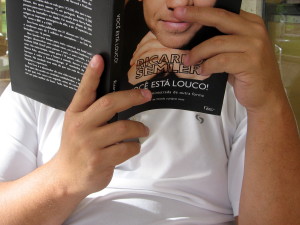 One of the chief complaints (or worries) among marketers is that people don’t read any more.
One of the chief complaints (or worries) among marketers is that people don’t read any more.
As if it’s a new situation that we need to adjust for.
But the truth is, it’s nothing new. Recently, I was reading Claude Hopkins’ Scientific Advertising — written in 1923, mind you — and look what I found:
Some say, “Be very brief. People will read but little.” Would you say that to a salesman? With a prospect standing before him, would you confine him to any certain number of words? That would be an unthinkable handicap.
Sounds like it was written last year, not last century.
Which puts a different spin on the question of long copy versus short.
Most people aren’t “readers”
It’s true that few people are readers. But according to Claude Hopkins, that’s always been true.
People haven’t suddenly lost the ability to read. There are simply people who enjoy reading and those who don’t.
If anything, literacy has improved over the years. In 1920, approximately 6% of Americans were illiterate. Now, less than 1% are classified that way (source: NAAL).
What’s really interesting about those statistics is that we now rate literacy more loosely — and the number has still gone down.
Current statistics measure functional illiteracy, not the inability to read and write. The 6% who were illiterate in 1920 were never taught to read at all.
I’d be willing to bet that if we went back and measured functional literacy in 1920, the percentage would easily hit double digits.
Short copy, schmort copy
Looking at it this way, using literacy statistics to justify short copy isn’t valid.
Here’s what is valid: People are overwhelmed by marketing messages. I’ve seen varying numbers, but on the whole, people are bombarded by 400,000 to 500,000 marketing messages every day.
That’s a lot.
Add social media and the faster pace of life, and you have a different issue. Even people who love to read don’t have time.
Readers are becoming scanners.
That doesn’t change the facts
Readership isn’t the issue. Studies have proven that long copy still performs better.
So you have to ask yourself why.
Why, when fewer people take time to read every word, does a 2,000-word landing page work better than a 300-word page? And why does a 5,000-word landing page outperform them both?
The truth?
Information sells.
Hopkins says it in the quotation above. Of course, he’s talking about one-on-one sales, but it applies to written copy as well.
Once you’ve done the work of getting someone’s attention, why would you give only the barest facts? Why wouldn’t you give a complete sales presentation that answers every question and overcomes objections?
People read when they need information
The fact is, people do read.
We may have “selective interest.” We may read more when we have a need or a problem. But we do read.
Furthermore, when we’re ready to make a purchase, we actively seek out information. The more information we can find, the better we like it.
Over the years, I’ve seen several reactions to this people-don’t-read issue.
- Short copy that doesn’t give enough information to persuade.
- Hyped copy that tries to manipulate results.
- No copy. These ads use images only, thinking that will get better results.
- Movie-length videos that read the promotion to you. (As if that takes less time!)
But we need to remember that readership isn’t the real problem. People do read when they need information.
- People read when they’re interested in something.
- People read when they’re considering a purchase.
- People stop reading when the BS button gets tripped. (Keep it real. There’s no need for hype.)
- When people do read, it’s because they want information, so don’t be afraid to give it.
- More information sells better.
- People tend to buy from the one who gives them the best information.
So our challenge is to write in a way that overcomes reader resistance.
Long copy still persuades best
When people are considering a purchase, they want information. They’ll do a Google search, talk to friends, post questions on social media, and read reams of copy.
What are they looking for?
- Information about the product.
- Whether it really works.
- Whether the seller is trustworthy.
Bottom line, they want to be sure the product will do what it says it will do and whether it’s worth the money.
In many cases, the brand that gives them the answers they’re looking for is the brand that wins their trust.
So when it comes to the question of long copy or short, don’t limit yourself.
Describe your product, its features and benefits. Help people see themselves using the product. Give testimonials from satisfied customers. Address common objections. Offer guarantees to remove fear. Then push the sale.
Go as long as necessary to give a complete presentation.
In the words of Hopkins:
No one reads ads for amusement, long or short. Consider them as prospects standing before you, seeking for information. Give them enough to get action.

